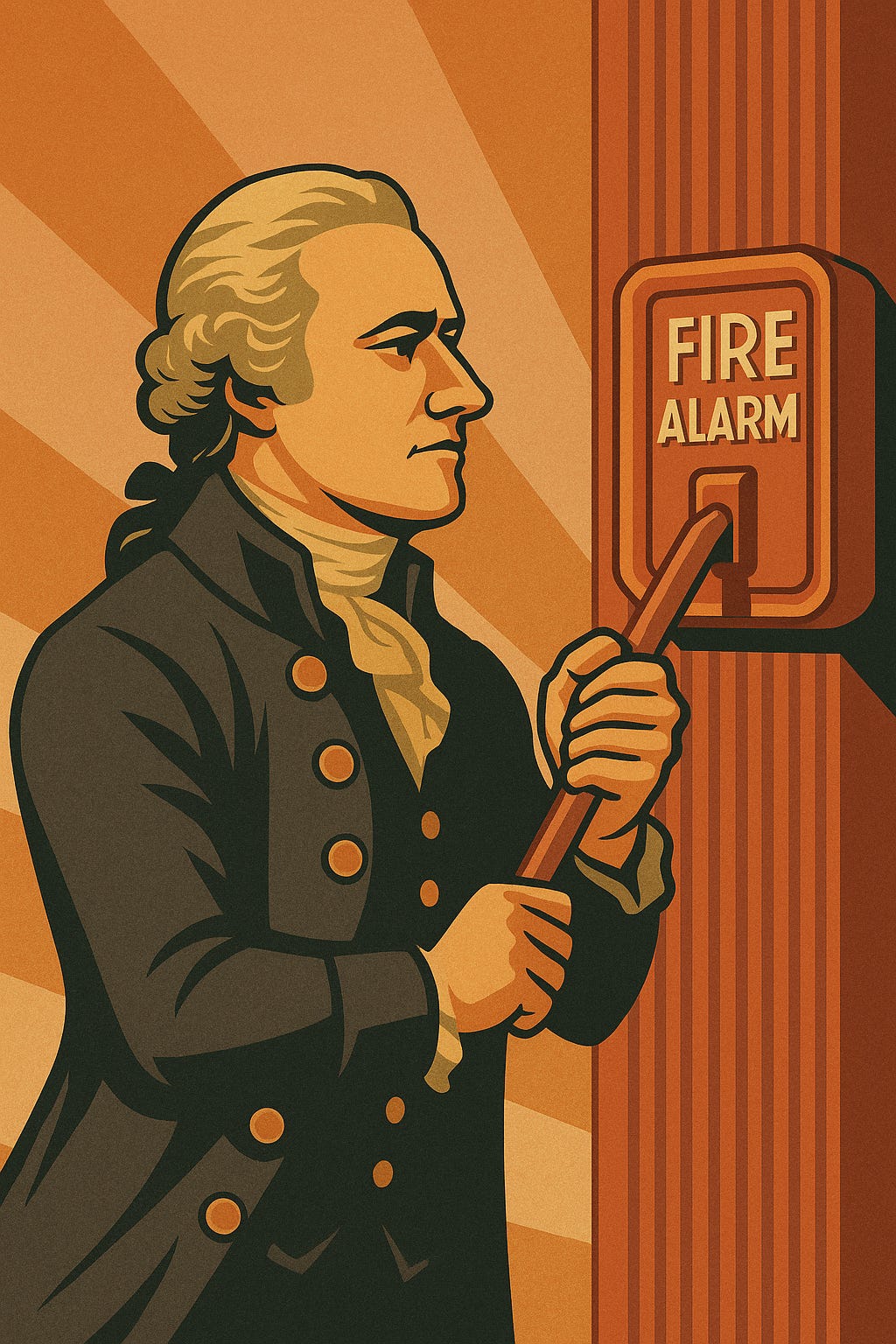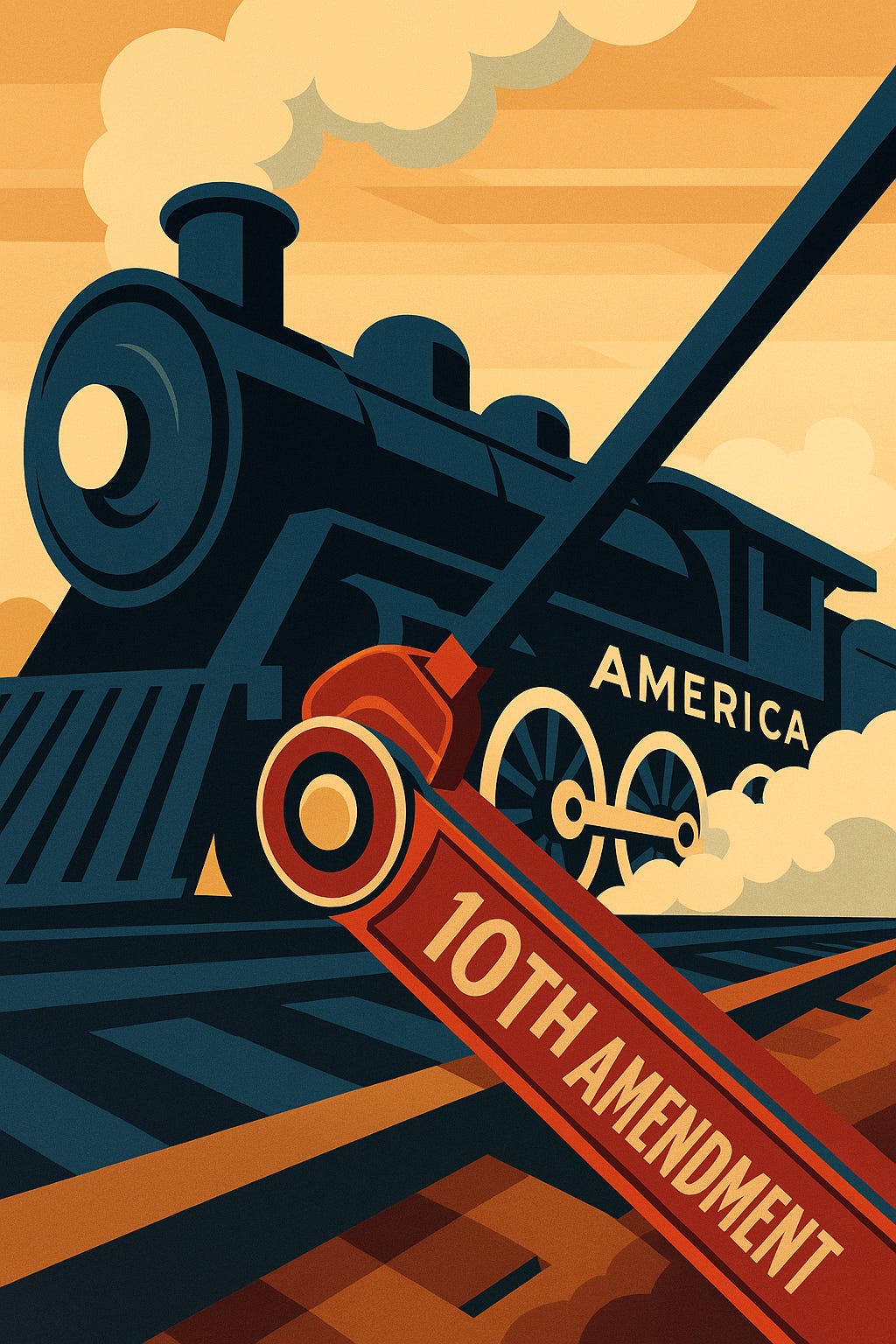The Federalists Reloaded | No. 16
The Fight Between Energy and Restraint
Hamilton’s Fire Alarm
When Alexander Hamilton called the American government an “imbecility,” he was not exaggerating for effect. He meant it. Under the Articles of Confederation, Congress could request money or troops from the states, but the states retained the authority to refuse. And often, they did.
The result was a Union that appeared to be a government on paper but failed whenever it attempted to act in reality. The nation sank deeper into debt, its reputation abroad withered, and its people lost confidence in their leaders. Hamilton captured the moment in Federalist No. 15 when he wrote, “We may indeed with propriety be said to have reached almost the last stage of national humiliation.”
That essay was Hamilton’s alarm bell. But an alarm does not put out the fire. In Federalist No. 16, Hamilton tried to offer a cure.
The Flaw That Killed the Confederation
The weakness of the Articles lay not only in their limited power, but also in the design itself. The federal government could act only on the states, not directly on the people. That meant compliance was always voluntary, and when states refused, the only way left to enforce the law was through force.
Hamilton did not shy away from pointing out how absurd this was: “Who can pretend that force will ever be employed against the collective body of a State? Or, if it could, would it be the means to secure the execution of the laws?”
In other words, a government that must raise an army every time it wants obedience is no government at all. It is a recipe for conflict, not order.
Hamilton’s Fix
Hamilton’s solution was bold and practical. Stop acting through states and begin acting directly on individuals. Tax citizens directly. Regulate them directly. Take disputes to courts that speak with federal authority. Enforce laws with officers who answer to the Union. That, Hamilton argued, is how real governments work.
The government of the Union, like that of each State, must carry its agency to the persons of the citizens.
This was the leap. By bypassing state governments and reaching individuals, the Constitution created a Union that no longer relied on the goodwill of the states to survive. Hamilton believed that voluntary cooperation was not enough. What mattered was structure and enforceable authority.
The Anti-Federalist Pushback
To Hamilton’s critics, this was not a cure but a threat. The Anti-Federalists feared that a federal government with direct power over individuals would consume the states and erode liberty.
Brutus warned: “The powers of the general legislature extend to every case that is of the least importance. There is nothing valuable to human nature, nothing dear to freemen, but what is within its power.”
Where Hamilton saw survival, Brutus saw suffocation. In another essay, he cautioned, “The laws of Congress are supreme and control the constitutions and laws of the several states, and cannot be controlled by them.”
Centinel echoed the warning: “Instead of securing your rights, you will find them gradually consumed by a power paramount to your constitutions.”
And Patrick Henry, in the Virginia Ratifying Convention, cut to the heart of the fear: “The Constitution is said to have beautiful features. But when I come to examine these features, sir, they appear to me horribly frightful. Your President may easily become king.”
Hamilton’s engine sounded to his opponents like the machinery of tyranny.
The 10th Amendment: The Brake Pedal
The Constitution was ratified, but the anxiety never disappeared. To calm it, the framers promised limits on federal authority. That promise took shape in the Bill of Rights, and above all in the 10th Amendment:
The powers not delegated to the United States by the Constitution, nor prohibited by it to the States, are reserved to the States respectively, or to the people.
The 10th did not undo Hamilton’s fix. Federal law still binds individuals. But it did draw a boundary. Federal power was limited to what the Constitution specifically delegated. Everything else remained in the hands of the states or the people themselves.
Hamilton had built the engine. The 10th Amendment installed the brake.
The Fight in Practice
This tension between energy and restraint has shaped American history ever since.
Civil War and Reconstruction
The war settled Hamilton’s point that states could not simply defy the Union. Yet the aftermath also showed the power of the 10th, as Southern states fought to limit federal oversight of their laws.
Civil Rights Act of 1964
Congress outlawed segregation using its power over interstate commerce. Critics claimed this trampled on states’ rights. Hamilton likely would have shrugged. A Union that could not enforce equality on individuals was hardly a Union at all.
Marijuana Legalization
Today, federal law still bans cannabis, yet states from Colorado to California have legalized it. The fractured enforcement looks like Hamilton’s nightmare of “imbecility,” but to many, it also seems like the 10th Amendment at work.
Immigration and Sanctuary Cities
Federal law says one thing, but states and cities resist. Courts are left to decide where Hamilton’s energy ends and the 10th’s protection begins.
Environmental Regulation
California pushes stricter car standards, while Texas fights the EPA. Each claims authority under the 10th Amendment, while Washington insists that federal rules must prevail. The tug-of-war continues.
Hamilton Was Right
Hamilton’s warning was no exaggeration. A Union that could act only through the states was not a Union at all. His solution, direct federal authority over individuals, was the only way the United States could survive.
Laws are a dead letter without courts to expound and define their true meaning and operation.
Without Hamilton’s fix, the Civil War could not have been won, Reconstruction could not have been attempted, and civil rights laws could not have been enforced.
…But So Were His Critics
Yet the Anti-Federalists were not wrong either. A federal government with too much energy can overreach, and the 10th Amendment remains its enduring gift.
It has armed both sides of the political spectrum. Progressives have used it to defend marijuana legalization and sanctuary policies. Conservatives have used it to resist federal mandates and environmental regulations. The fact that everyone reaches for the 10th shows how vital it still is.
Hamilton’s engine keeps the Union alive. The 10th Amendment keeps it from running out of control.
The Struggle That Defines Us
We still live inside the tension between Hamilton’s energy and the 10th Amendment’s restraint. At times, Washington feels too weak, paralyzed by gridlock or open defiance. At other time,s it feels too strong, pushing into schools, clinics, and communities.
That tension is not failure. It is the design. Hamilton gave us a Union strong enough to hold together. The Anti-Federalists demanded protections to ensure liberty would not be compromised. The Constitution gave us both.
The Modern Question
So where does that leave us today? Federalist 15 sounded the alarm that a powerless Union could not survive. Federalist 16 outlined the cure, granting the government direct authority over citizens. The 10th Amendment drew the boundary, reserving all powers not explicitly granted to the federal government to the states and the people.
The central question has not changed. How much throttle, how much brake? Too little power, and the Union fractures. Too much, and liberty erodes.
We may never resolve that tension. Perhaps we are not supposed to. The framers constructed a government designed to operate in a state of tension, not harmony. More than two centuries later, we are still fighting over Hamilton’s engine and the 10th Amendment’s brake.
That fight is not a flaw in the Constitution. It is the Constitution. And here is the uncomfortable truth: America only works when Hamilton’s energy and the Anti-Federalists’ restraint keep pulling against each other. The moment one side wins outright, the Republic loses its independence.






Scott - the more I read your work (mind you my college degree is in political science), the more I think that we need to revamp civic education. Looking back, it makes sense that we started with the Articles of Confederation given the failed experience of patrimonialism over several millennia. I wish more people understood this history on how the Constitution is designed to replace the corruption and incompetence of patrimonialism. As Yuval Levin wrote recently, we created a system to pursue public policy through argument instead of force. Keep up the great work!